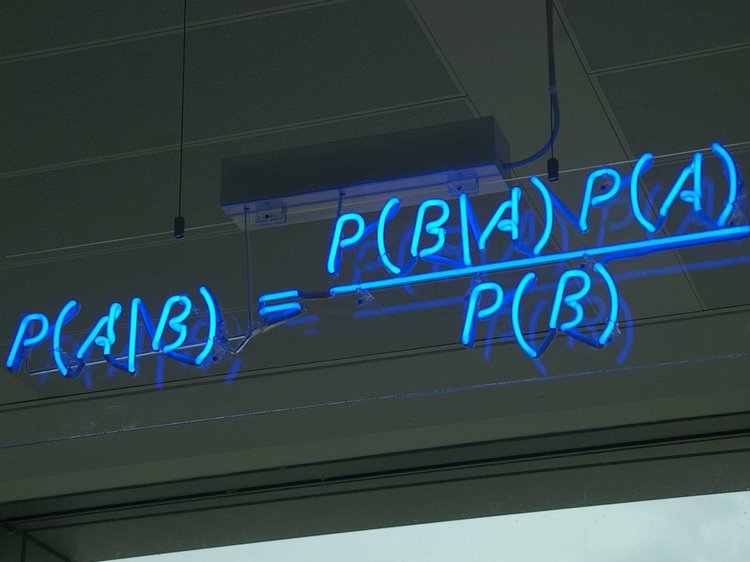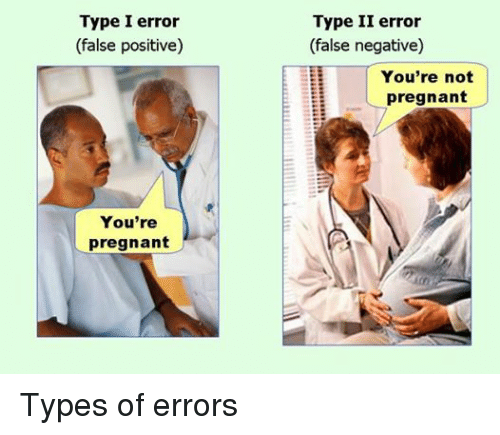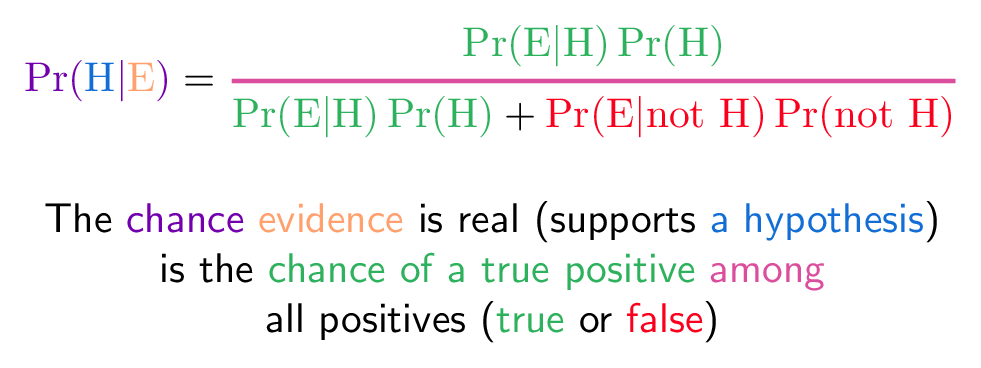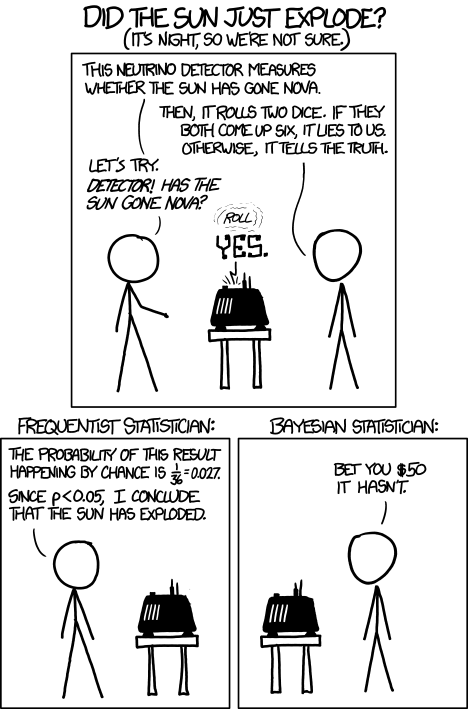class: center, middle, inverse, title-slide # Week 10 - Probability ## Brief Review, Bayes’ Theorem <html> <div style="float:left"> </div> <hr color='#EB811B' size=1px width=800px> </html> ### Danilo Freire ### 3 April 2019 --- <style> .remark-slide-number { position: inherit; } .remark-slide-number .progress-bar-container { position: absolute; bottom: 0; height: 6px; display: block; left: 0; right: 0; } .remark-slide-number .progress-bar { height: 100%; background-color: #EB811B; } .orange { color: #EB811B; } </style> # Today's Agenda .font150[ * Brief review: - Permutations - Combinations - Conditional probabilities * Bayes' theorem/rule ] --- # Review: Permutation .font140[ * Permutation is just a fancy name for _the number of ways we can arrange things_ * Example: in how many ways can we arrange 3 people? ] -- .font140[ * We can count: * ABC / ACB / BAC / BCA / CAB / CBA -- _6 ways_ ] -- .font140[ * Or we can think like this: - How many people can we pick for the first seat? 3 - How many people we can pick for the second seat? 2 - And for the last one? 1 * Therefore, we have `\(3 \times 2 \times 1 = 3! = 6\)` ] --- # Review: Permutation .font150[ * In how many ways can 5 people sit in 3 chairs? ] -- .font150[ * 5 in the first chair, 4 in the second, 3 in the third... _and that's all_: `\(5 \times 4 \times 3\)` `$$\frac{5 \times 4 \times 3 \times 2 \times 1}{2 \times 1} = \frac{5!}{2!}$$` * Formula = `\(\frac{n!}{(n - k)!}\)`, where `\(n\)` is the number of people and `\(k\)` is the number of places/seats ] --- # Review: Combinations .font150[ * Combinations are similar to permutations, except that _the ordering doesn't matter_ * So ABC, ACB, BAC, BCA, CAB, CBA are 6 permutations but _only one combination_ * To calculate how many combinations one can get, we can .orange[take the number of permutations then divide by the possible combinations] * We do that to _because we're counting the same group in different ways_ ] --- # Example: Combinations .font150[ * We have 6 people and 3 chairs. How many permutations are there? And how many combinations? ] -- .font150[ * Permutations: `\(6 \times 5 \times 4 = 120\)` ] -- .font150[ * Combinations: We know can arrange the same 3 people in 6 different ways * ABC / ACB / BAC / BCA / CAB / CBA * So we can just divide the total of permutations to the ways we can pick 3 people to discount the excess counting: `\(\frac{120}{6} = 20\)` combinations ] --- # Review: Combinations .font150[ * Formula: `\(\frac{n!}{k!(n-k)!}\)` * We take `\(\frac{n!}{(n-k)!}\)`, the permutations, then divide by `\(k!\)`, the number of repeated permutations (the formula multiplies the fraction by `\(k!\)` to cancel the denominator) * In `R`: ```r choose(6, 3) ``` ``` ## [1] 20 ``` ] --- # Review: Conditional Probability .font150[ * If we have prior information about something, this changes the way we calculate events * Many real world events are conditional to one another `$$P(A|B) = \frac{P(A \operatorname{and} B)}{P(B)}$$` * `\(P(A \operatorname{and} B)\)` probability of `\(A\)` and `\(B\)` happening together * `\(P(B)\)` marginal probability of `\(B\)` ] --- # Example: Conditional Probability .font120[ * Researchers surveyed 100 students on which superpower they would most like to have. This two-way table displays data for the respondents: | Superpower | Male | Female | **Total** | | :----------- | :--- | :----- | :-------- | | Fly | 26 | 12 | 38 | | Invisibility | 12 | 32 | 44 | | Other | 10 | 8 | 18 | | **Total** | 48 | 52 | 100 | * Find the probability that the student was male, given the student chose to fly as their superpower] -- .font120[ * `\(P(Male|Fly) = \frac{P(MaleAndFly)}{P(Fly)} = \frac{26}{38} \approx 0.68\)` ] --- # A Slightly Harder Example .font140[ * John's two favourite foods are bagels and pizza. `\(A\)` represents the event he eats bagel for breakfast and `\(B\)` represents the event that he eats pizza for lunch. * On a random day, the probability John will eat a bagel, `\(P(A)\)`, is `\(0.6\)`, the probability he will eat pizza is `\(P(B) = 0.5\)`, and the conditional probability that he eats a bagel for breakfast, given that he eats pizza for lunch is `\(P(A|B) = 0.7\)` * Based on this information, what is `\(P(B|A)\)`, that is, the probability that John will eats pizza for lunch given that he eats a bagel for breakfast? ] --- # Step-by-step .font150[ * P(A) = 0.6; P(B) = 0.5; P(A|B) = 0.7 * P(B|A)? ] -- .font110[$$P(A|B) = \frac{P(A \operatorname{and} B)}{P(B)}$$] -- .font110[$$P(B|A) = \frac{P(A \operatorname{and} B)}{P(A)}$$] -- .font110[$$P(A|B) \times P(B) = P(A \operatorname{and} B)$$] -- .font110[$$P(B|A) \times P(A) = P(A \operatorname{and} B)$$] -- .font110[$$P(A|B) \times P(B) = P(A \operatorname{and} B) = P(B|A) \times P(A)$$] -- .font110[$$0.7 \times 0.5 = 0.35 = P(A \operatorname{and} B) = P(B|A) \times 0.6$$] -- .font110[$$\frac{0.35}{0.6} = P(B|A) \approx 0.58$$] --- # Let's See that Again .font150[ `$$P(A|B) = \frac{P(A \operatorname{and} B)}{P(B)}$$` `$$P(B|A) = \frac{P(A \operatorname{and} B)}{P(A)}$$` `$$P(A|B) \times P(B) = P(A \operatorname{and} B) = P(B|A) \times P(A)$$` `$$P(A|B) = \frac{P(B|A) \times P(A)}{P(B)}$$` ] --- # Bayes' Theorem .center[] --- # Bayes' Theorem .font150[ * `\(P(A)\)` = prior probability * `\(P(A | B)\)`: posterior probability of event `\(A\)` given observed data `\(B\)` * `\(P(B | A)\)`: probability of observing `\(B\)` given `\(A\)` * `\(P(B)\)`: probability of observing `\(B\)`.... including both true and false positives! ] --- # False Positive .center[] --- # Bayes' Theorem .center[] --- # Medical Test .font150[ * Imagine you have a serious disease. It is a rare disease, it happens only to 0.1% of the population. The test identifies the disease correctly in 99% of the cases, but incorrectly in 1% of them. If your test is positive, what is the probability you actually have the disease? ] --- # Medical Test .font150[ `$$P(H|E) = \frac{P(E|H) \times P(H)}{P(E)}$$` `$$P(H|E) = \frac{P(E|H) \times P(H)}{P(E|H) \times P(H) + P(E|H^c) \times P(H^c)}$$` `$$P(disease|test+) = \frac{P(test+|disease) \times Prior(disease)}{P(test+) = \operatorname{true and false positives}}$$` ] --- # Medical Test .font150[ * Imagine you have a serious disease. It is a rare disease, it happens only to 0.1% of the population. The test identifies the disease correctly in 99% of the cases, but incorrectly in 1% of them. If your test is positive, what is the probability you actually have the disease? `$$P(H|E) = \frac{.99 \times .001}{.001 \times .99 + .999 \times .01} \approx .09 \approx 9\%$$` ] --- # Medical Test .font150[ * Out of 1,000 people, 1 will actually have the disease * But 10 people will be tested positive _and will not have the disease_ * Which means that 11 people will be tested positive overall * So we have `\(\frac{1}{11} \approx .09 \approx 9\%\)` ] --- # Will the Sun Rise Tomorrow? .center[] --- # Bayesian Updating .center[] --- # xkcd .center[] --- class: inverse, center, middle # Questions? <html><div style='float:left'></div><hr color='#EB811B' size=1px width=720px></html> --- class: inverse, center, middle # See you next week! <html><div style='float:left'></div><hr color='#EB811B' size=1px width=720px></html>